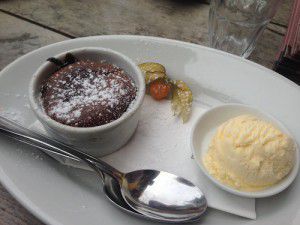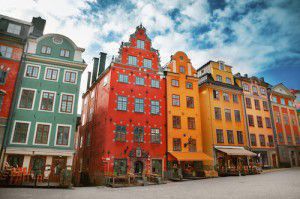10 reasons to visit Vienna
Today’s ’10 reasons’ guest post comes from Charlotte, who’s currently living and working in Vienna, Austria. If you’d like to read more from Charlotte, you can follow her blog or find her on Twitter.
So here are 10 reasons to visit Vienna… Do you have any to add?
1. Have you seen how pretty it is?
One of the first things you’ll notice, if you go to Vienna, is the architecture. You name an architectural style and there are probably buildings in Vienna based on it, in some shape or form. And even if you’re not a massive fan of the City Hall, or the Burgtheater, then there are plenty of places to enjoy more modern buildings and designs, like the huge Main Public Library or even sitting on the Enzis (some colourful outdoor furniture) in the inner courtyard of the MuseumsQuartier. My favourite building in Vienna is the Hundertwasserhaus, a definite must see – and it’s not like it costs anything to look at it!
2. You can catch an opera or go to a museum.
There’s certainly plenty to choose from in the opera department. The Vienna State Opera (Staatsoper) offers more than 350 performances per season – that’s ballet, opera, and different concerts. If you don’t mind standing, it’s also not too expensive, though you do have to queue for a while beforehand. However, this is one of those things I would recommend if you aren’t in a hurry and you have a little bit of extra cash. Where would be a better place to see an opera but this historical city in a country famous for its musicians? Plus, there are a lot of museums in Vienna. There’s the Natural History Museum, the Art History Museum, the Leopold Museum, the Jewish Museum, the Museum of Technology… There are, in fact, over 100 museums in this city. Some of them are old palaces – like Belvedere or Liechtenstein City Palace – and some of them might seem odd – like The Third Man Museum or the Funeral Museum – but they’re all interesting and there’s something here to suit everyone.
3. You can eat at the Naschmarkt.
I’m not going to lie, the Naschmarkt is one of my favourite places in Vienna, for one reason only – it sells food. It’s around 1.5km long and people there sell spices, fresh fruit and vegetables, cheese, seafood, meats, bread… You name it and they probably sell it there. Plus, there are a bunch of small restaurants where you can sit and eat anything from Chinese dumplings to baklava to traditional Viennese food like Palatschinken. Yum!
4. You can chill out on the Donauinsel.
The Danube runs through Vienna, as it does through many other European cities, but here they’ve got an island that runs along the middle of it and you can reach on the subway. Especially popular in the summer, you can sit and have a picnic, or read, or do what others are doing and rollerblade or bike around it. Plus, every year they hold the Donauinselfest, an outdoor music festival and Europe’s biggest open-air event. Considering that its main purpose is to protect Vienna from flooding, it has developed into one of the main areas of entertainment in the city and is a lovely place to waste away a day or three.
5. You can – and should – eat Sachertorte.
Sachertorte is to Vienna what the Victoria Sponge is to the UK – maybe people don’t eat it every day, but they’re certainly aware of its existence and will take the time to explain to you that you should try it as soon as possible. What it actually is, is a dense, delicious, chocolate cake with dark chocolate icing, held together by apricot jam (yes – the apricot jam might seem a little strange at first, but when you consider that in the Austrian dialect they actually have their own separate word for apricot, then you’ll understand that you’re going to come across it often and maybe in surprising places). The ultimate place to eat it, apparently, is at the Hotel Sacher, but you can buy Sachertorte at probably every café in the city. Make sure you get a slice if you’re in Vienna on the 5th December – that’s National Sachertorte Day.
6. Vienna has the oldest zoo in the world!
You may have already heard of Schönbrunn Palace, which is an imperial summer palace and worth a visit, particularly on a sunny day. Well, on the same grounds is the Tiergarten Schönbrunn (Schönbrunn Zoo), which, having been founded in 1752, claims to be the oldest zoo in the world. It is one of a few zoos to house Giant Pandas (including three that were born in the zoo) and currently houses over 700 species. It is also one of few attractions in Vienna that is open 365 days a year (most things close on Sundays) – so you can go whenever you feel like it.
7. You can visit St. Stephen’s Cathedral.
It can get a bit dull visiting churches and cathedrals all the time, especially in a country like Austria, which is teeming with them, but if you only choose to visit one, then choose this one. This is Vienna’s landmark and it is the most important religious building in the city, and if you don’t feel like just going in for a look around, there is always the opportunity to attend a concert here instead. Plus, it sits on Stephansplatz, basically the city centre, so it’s not like you’ll miss it.
8. It’s an easy task to go wherever you want.
So maybe I shouldn’t highlight ways to leave the city in a post about why you should go there, but considering Vienna’s – and Austria’s – position in Europe, this was bound to come up. The fact is, it’s really easy to go somewhere else and, in most cases, it’s quite cheap too. It’s an hour to Bratislava; you just hop over the border into Slovakia and it’s less than 20€ for a return ticket. It’s three hours to Budapest, the other capital of the Austro-Hungarian empire (and worth a visit if you’re interested in exploring that theme) and four hours to Munich, or Innsbruck, or Prague. You can get cheap tickets to all of these places too, provided that you book in advance or that you get hold of some kind of discount card (not difficult to do). So, you know, if there isn’t quite enough to keep you entertained in Vienna, you can always make a quick trip somewhere else.
9. You can visit the Prater.
The Prater is a huge public park in Vienna, but probably the most famous part of it is the Wurstelprater amusement park, which takes up one corner. This is the home to the Wiener Riesenrad (the Ferris wheel), along with plenty of other rides, but also restaurants, bars, a Madam Tussauds and at least one night club. You could spend a day and a night here, if you wanted, as there’s plenty to do and as it costs nothing to get in (you pay per attraction), you can just wander around the park and explore.
10. If you come in December, you can visit a Christmas Market or five.
Much like the thing with the apricots, the Austrians have a different name for Christmas Markets (Christkindlmarkt) to their German counterparts, but the principle is somewhat similar. Late October to early November, you’ll see the stands being built and lights being strung – and then from the first weekend of November, the markets begin to open, selling drinks and food and decorations and gifts. I’m not sure exactly how many Christmas Markets there are, but essentially they’re everywhere, so you’ll just stumble across them as you wander the city. Like Germany, Glühwein (mulled wine) is a big thing here, but so is punch – and if you’re not so into the wine, you can buy Glühbier (mulled beer) in certain places. If you don’t drink at all, then there are plenty of places that offer non-alcoholic punch, in a variety of places. So, get a drink, buy yourself some food and soak up that festive atmosphere!
Charlotte
xuexisprachen.wordpress.com
@luna_moonsilver
(Photo credit: Charlotte Donnelly)
Do you have a favourite place that everyone should know about? Let us know!
Helping yourself to learn a language
Before launching into an ‘only teacher knows best’ tirade, which would sound incredibly biased as I am a language teacher myself, I would like to open with the statement that self-study is an essential part of learning a language. What happens in your classroom or with your private tutor is a good start, but anyone who tells you that this is all you have to do to learn a language is telling you a lie. Sorry about that.
 Classes are a great experience, yes, but like any new skill you want to learn, it is best to approach learning from many angles. There is no point having one lesson a week and then doing nothing at all, or, even more sinful, leaving that homework you promised yourself you would do until the night – or hour – before your next lesson. You are wasting your time and money, and yes. Us teachers can tell.
Classes are a great experience, yes, but like any new skill you want to learn, it is best to approach learning from many angles. There is no point having one lesson a week and then doing nothing at all, or, even more sinful, leaving that homework you promised yourself you would do until the night – or hour – before your next lesson. You are wasting your time and money, and yes. Us teachers can tell.
Having gone down the self-learning route myself, I’ve come across some resources I’d love to share with you.
Take for example things like Livemocha. A good all-round resource that is set up to partner you up with other language learners through language exchange, short online lessons, and lots of forums. It’s interactive, there’s always something new, and it’s free. What’s not to love?
If you don’t want to concentrate specifically on language learning and are looking for more of a language exchange/international vibe, Interpals could be the place for you. This site is a bit like a mix between Facebook and InterNations, so treat it with the same joy or disdain you do either of them. There are amazing connections to be made out there but then again there are also many to sever. Choose your friends wisely and never be afraid to use the block button with flair.
Not sure you’re ready for full-on instant message conversations just yet? Something like mylanguageexchange.com might be what you need. While both text and voice chat options are available, what I really like about this is the penpals who are happy to write either by email or even by traditional snail mail. Gifts in the post. Need I say more?
Another tool that is well worth trying is EuroTalk’s interactive series, Talk Now. This is a really easy way to pick up a good vocabulary base and I like the exposure to a lot of different accents. Yes, it is ‘staged’ because it’s a course, but if you’re concerned about who you’re speaking to out there or want to get confident first so that you can tell those with ulterior motives to ‘go away’ with perfect pronunciation, it really is a good investment.
As far as mobile apps go, I like Memrise for its simplicity. It’s sort of a drip-feed method of learning: you learn a series of words and there are ‘helpful’ memes sent in by users – I say ‘helpful’ because some really are helpful, some are hilarious so they just make you giggle, and some make you question the human race.
 Finally, there’s uTalk. This is a great time killer. All those moments sat waiting for the metro or in my case, waiting for students to finish their meetings when our lessons are due to start, can now be filled with quick and easy games to help you learn your desired language. Put down the Candy Crush, step away from the Jurassic Park Builder and pick up some new words!
Finally, there’s uTalk. This is a great time killer. All those moments sat waiting for the metro or in my case, waiting for students to finish their meetings when our lessons are due to start, can now be filled with quick and easy games to help you learn your desired language. Put down the Candy Crush, step away from the Jurassic Park Builder and pick up some new words!
Now, all these resources are tailored specifically towards learning a language. But there are other, more natural ways of learning.
Watching films in your target language but with English subtitles is an excellent way to learn, as is listening to real local radio – TuneIn is fantastic for this as it lets you search by locations the world over.
Find out about typical newspapers. In my case I used Helsingin Sanomat and found this from a quick Wiki search for ‘popular newspapers in Finland’. There will likely be an online version of your chosen paper and if you get stuck with translating you can either translate the entire page depending on your browser choice, or copy and paste the article directly into Google Translate.
Translate Eurovision entries, listen to commentary of your favourite sport in another tongue, embrace the possibility that there are songs out there in other languages that you will love – then translate and learn them by heart.
Changing the language of your social media and phone will also help, but that is for the brave and sure. Do this only if you’re confident you know enough of the language to avoid embarrassing mistakes.
Last of all, if you get the opportunity to speak, speak. If you overhear someone talking in the language you are learning, don’t be afraid to go over and say hello. Yes, perhaps you’ll startle them. But in my experience, it is just shock that a native English speaker has taken the time to bother to learn their language at all. Their first question to you will probably be ‘why are you learning…..?’
There are a million ways to learn. Try some 🙂
Kelly
How to be English: a beginner’s guide
Because there’s nothing the English do better than laugh at ourselves, we had a lot of fun yesterday putting together this beginner’s guide on how to be English.
Send us your suggestions and we’ll add our favourites!
8 ways to feel confident about speaking a language
So you’re off on holiday, and you’ve decided you’re going to speak a bit of the local language. You get a EuroTalk program (obviously), start learning a few key phrases, and you’re feeling good.
But then you get off the plane and the doubts start to creep in. What if people laugh at your accent? What if you say what you need to say perfectly, but don’t understand the reply? What if you open your mouth and instantly forget everything you’ve learnt?! Probably safer to stick to English, or sign language. Right?
 It is scary starting to speak another language. I get incredibly nervous – more so, ironically, with Spanish, which is a language I studied for years but haven’t spoken properly for a while. But sometimes you just have to throw yourself into it and see what happens. The worst that’s going to happen is that you don’t understand each other, but the reality is nobody’s going to laugh at you for trying to speak their language, or blame you if you make a mistake.
It is scary starting to speak another language. I get incredibly nervous – more so, ironically, with Spanish, which is a language I studied for years but haven’t spoken properly for a while. But sometimes you just have to throw yourself into it and see what happens. The worst that’s going to happen is that you don’t understand each other, but the reality is nobody’s going to laugh at you for trying to speak their language, or blame you if you make a mistake.
Now, obviously I realise ‘just throw yourself into it’ is a lot easier said than done. So here are some tips to help your confidence, before and during your conversation.
Go prepared
Bit of an obvious one, but you should try and learn at least a few words, so that you’re not going in to the conversation completely unprepared. At least that way you start off in control. It’s probably a good idea to learn how to say ‘I don’t understand’ and ‘please speak more slowly’ as well; at least that way if you do get stuck you’ll be able to do something other than stare blankly.
Find a language partner to chat to before you go
Learning on the computer or your phone is great for learning vocabulary and perfecting your accent, but at the end of the day, learning a language is obviously about conversation. If you’ve got a friend who speaks the language you’re learning, or is learning as well, set aside some time regularly to chat with them. It’ll be easier with someone you know and feel comfortable with than with a stranger, as you won’t be so worried about making mistakes.
Take uTalk with you
Because if your mind goes blank, you can grab your phone and search for the word you need in seconds. uTalk is much quicker (and better-looking) than a phrasebook, and it tells you how to say the word as well. Bonus.
Ban yourself from speaking your own language
I recently discovered Scott Young’s blog; he and a friend just spent a year travelling around four different countries, attempting to speak no English and immerse themselves completely in the local language and culture. This might seem quite drastic, but I can’t think of a better way to feel confident quickly – given a choice between speaking to people in another language or not speaking to anyone at all for three months, I know which one I’d choose.
Try thinking in the language
I’ve tried this approach before in Spanish and found it quite effective. When you look around your house, try and think what the objects are called in the language you’re learning, rather than English. (FlashSticks are useful for this sort of thing.) Try and think about a TV show you just watched, and explain it to yourself in the other language. Go outside and try to name as many everyday sights as you can. This way, it starts to feel like second nature and you may be surprised to find yourself doing it without trying.
Focus on how good you’ll feel afterwards
Have you ever had a conversation in another language? Remember how good you felt afterwards, when you were holding the train ticket you’d just bought, or eating the meal you’d just ordered? Any time you feel hesitant about starting a conversation, focus on that feeling and push on through. It’ll be worth it.
Make a phone call (a.k.a. jump in the deep end)
When I was at university, I spent my third year living in Madrid, and during my first few days I had to make lots of phone calls to try and find somewhere to live. And it was terrifying. I’m not really a fan of the phone at the best of times, but making calls in another language was twice as scary – without the aid of body language or facial expressions, it suddenly becomes a lot harder to understand what someone’s saying to you. But I did it, because I had to, and managed to successfully arrange several viewings; I’d never have thought I could do that before I left home.
And, if all else fails…
Have a drink
It’s a well-documented fact – mostly among students, for some reason – that having a drink or two actually improves your language skills. While that may not be entirely true, it does make sense that when you’re feeling relaxed, and your inhibitions are lowered, you’re going to feel more confident about giving it a go. Don’t have too many drinks though, obviously, or then nobody will understand you in any language.
Good luck!
Do you struggle with confidence when you’re speaking another language? How do you deal with it?
Liz
10 reasons to visit… Stockholm
When I first started planning my trip to Stockholm, I didn’t know exactly what to expect. I’d heard from everyone that went there that it’s a beautiful place, but had no specifics so I thought I’d do a bit of research – I’m an avid planner so I enjoyed the planning of the trip every bit as much as the trip itself. Below are 10 reasons why you should consider this great Scandinavian city as your next holiday destination.
1. Gamla Stan
This is the first thing you’ll find online about Stockholm. It’s the old centre of the city and is located on a small island. Actually, Stockholm is formed from more islands split by canals but they are very well interconnected. This district is a really special part of the city with colourful architecture, narrow streets paved with cubic rock, tall churches and last but not least, great cafés and restaurants. Just put down the map and get lost on the lovely streets, looking everywhere around you. When you get tired, have a break at Fabrique – amazing coffee and pastry.
2. Pastry
Oh, Swedish pastry. I intoxicated my Facebook friends for the whole length of my trip with photos of the delicious pastries that this country makes. If you have to try something from the Swedish cuisine, ditch the IKEA meatballs and go for the great, cinnamon or nutty tasting pastry. Have it at breakfast, with a creamy coffee (what the Swedes call ‘fika’) – guarantees a great start of the day. What am I talking about, have it any time you want and try ALL the varieties.
3. Observatorielunden
For a nice view over the city, go to Observatorielunden – it’s a park on a hill next to the Old Stockholm Observatory. From there, take a nice walk through Norrmalm’s streets, it’s a lovely area with shops both local and international. For a coffee break, go to Espresso House on Drottninggatan, one of the best decorated places I’ve ever been – great coffee and tea too!
4. Hammarby Sjöstad
Roughly translating as Hammarby Sea City or Hammarby Lake City, this is a very modern and new area of Stockholm and is part of the Södermalm district. Go there in the morning or even afternoon, perhaps to see the sunset as the area is surrounded by water and canals. You can then take the boat to return to the centre.
5. Skansen
Skansen is the world’s first open-air museum, founded in 1891. Here you can stroll through five centuries of Swedish history, from north to south, with a real sense of the past all around in the historical buildings and dwellings, populated by characters in period dress – according to their website. It was a really great place to see, especially as it started snowing while we were there – a very good reason to refugee in an old style café and have home-made pastry and sweets.
6. Swedish people
They have a lot of style, that is for sure. That reflects in their clothes, shoes, bags, decoration and anything that involves design, really. They are discreet, not very outgoing but friendly. If you are the kind of person that likes to get to know the locals you will have to put some active effort into it – try renting a room in a flat hosted by locals.
7. The Stockholm City Hall
The City Hall has an interesting building (with an interior garden) and location, next to Stadhusparken, which is a park surrounded by water. As long as you are there, check out the Radisson Blu Waterfront Hotel; it looks very cool.
8. Rosendals Trägård
Next to Skansen is Rosendals Trägård (Rosendal’s Garden) – an open garden, which wishes to present biodynamic (organic) garden cultivation. We didn’t get to go there, but apparently they have a café, plant shop and bakery, so what’s not to like?
9. Södermalm
One of the hipster districts of Stockholm, with a creative and relaxed vibe, offering a variety of Swedish fashion shops, vintage stores, galleries and design stores as well as well decorated cafés and bars. Here are also two of the best viewpoints in the city: Fjällgatan and Monteliusvägen.
10. Architecture
All around the city, I never laid my eyes on an ugly building. The Swedes have a great sense of what looks good and that reflects in everything. Interesting colourful buildings, wonderfully refurbished old ones. We particularly found the roofs worth a look at so if you are into that, be careful not to trip while looking up all the time.
Blend in with the locals – learn Swedish with uTalk so you can order pastry and coffee or even just to say ‘hello’ or ‘goodbye’. Everyone in Stockholm speaks very good English, but nothing compares with the feeling of seeing that smile on their faces when you use the local language in a casual conversation.
Ioana







